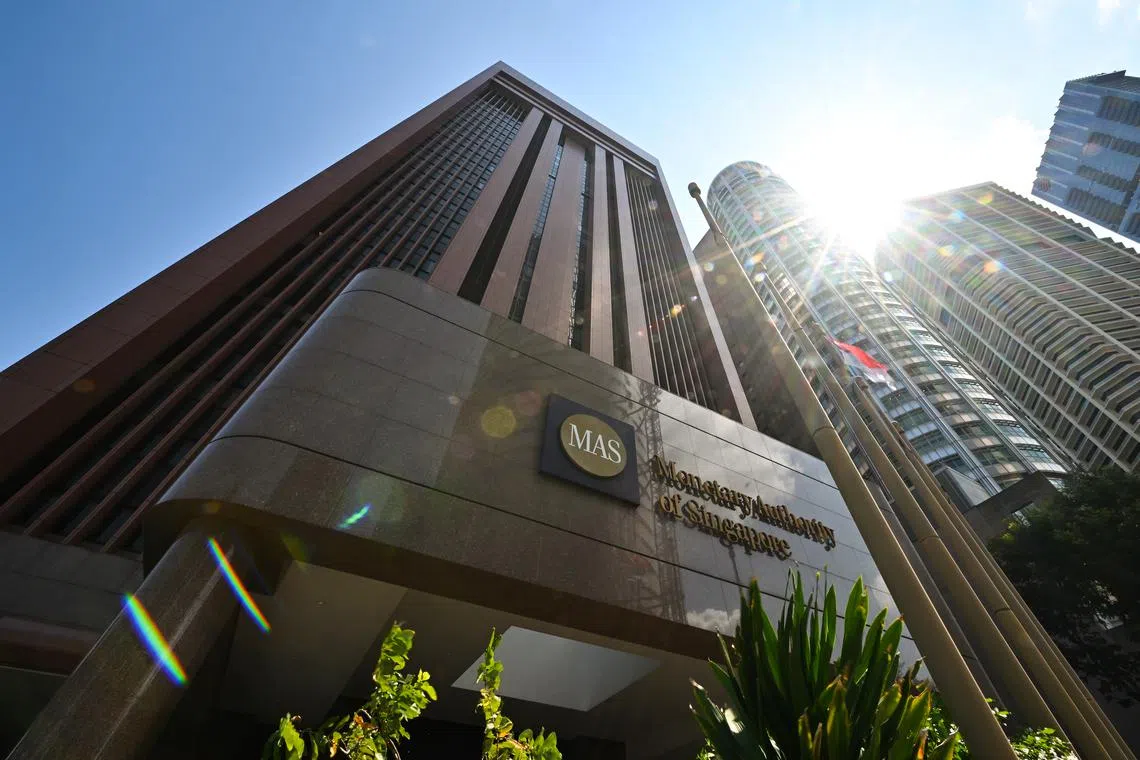MAS books net profit of $3.8b as global markets recovered, Singapore dollar weakened
Sign up now: Get ST's newsletters delivered to your inbox

MAS believes global growth will remain steady in 2024.
ST PHOTO: LIM YAOHUI
Follow topic:
SINGAPORE - Rebounding bond and stock markets worldwide and a weaker Singapore dollar have helped the Republic’s central bank swing to a net profit of $3.8 billion.
The Monetary Authority of Singapore (MAS), in its annual report for the financial year 2023-2024 ending March 31, 2024, said the profit was aided by an investment gain of $12.7 billion and positive currency translation effects of $1.7 billion, resulting in an overall profit of $14.4 billion.
In FY2022-2023, MAS recorded a net loss of $30.8 billion,
The central bank’s gains and losses emerge from its conduct of monetary operations to manage the Singapore dollar against a trade-weighted basket of currencies – also called the Singapore dollar nominal effective exchange rate (S$Neer) – aimed at achieving price stability in the medium term.
As part of the monetary operations, MAS may buy or sell currencies in the spot foreign exchange market. It also manages Singapore dollar liquidity in the banking system through money market operations.
The monetary operations may result in accumulation or depletion of the official foreign reserves (OFR), which stood at $497.6 billion at the end of FY2023-2024.
If the accumulation of OFR goes beyond the optimal size of about 65 per cent to 75 per cent of gross domestic product, MAS may subscribe to Reserves Management Government Securities (RMGS) for longer-term management by sovereign wealth fund GIC. This enables such foreign assets to be invested in longer-term, higher-yielding assets.
As MAS’ financial results are reported in Singapore dollars, currency movements of the Singapore dollar against foreign currencies of the OFR will result in translation effects in MAS’ financial statements.
MAS says currency translation effects are thus a consequence of the exchange rate-based monetary policy and have no impact on the international purchasing power of the OFR, or on MAS’ ability to conduct monetary policy and support financial stability.
The currency translation effect was positive in FY2023-2024 as the Singapore dollar eased against major currencies such as the US dollar, euro and British pound.
The annual report released on July 18 showed that MAS transferred $22.5 billion to the Government for management by GIC, with outstanding RMGS holdings increasing from $237.6 billion to $260.1 billion.
MAS received $9.7 billion in interest income from its holdings of RMGS. However, after offsetting interest income from RMGS, it incurred a net cost of $9.2 billion in its conduct of money market operations.
MAS said the investment gain in FY2023-2024 – which formed the bulk of the profit for the financial year – came about as global markets rebounded, particularly in the second half of the financial year, amid resilient global growth and moderating inflation.
It said the investment gain was mainly from interest income, dividends and realised gains from the management of OFR, offset by valuation provisions. Compared to FY2022-2023, all major asset classes, including developed markets and emerging markets bonds and equities, posted higher returns, MAS noted.
MAS believes global growth will remain steady in 2024, even as the impact of past monetary policy tightening and less supportive fiscal policy continues to exert some restraining effect.
“The global economy continued to display remarkable resilience in the first quarter of 2024,” MAS said in the annual report. “The benign growth backdrop will add momentum to the nascent upturn in the global electronics cycle, supporting emerging market Asia economies.”
Emerging market Asia includes Asian economies such as China, Hong Kong, India, Indonesia, Malaysia, Singapore, South Korea and Thailand.
Meanwhile, the Singapore economy is expected to attain growth of 1 per cent to 3 per cent in 2024, up from the 1.1 per cent expansion in 2023, MAS reiterated. The projection is in line with forecasts of the Ministry of Trade and Industry.
Mr Chia Der Jiun, managing director of MAS, said growth across the major sectors of the economy is expected to gradually return to pre-pandemic norms, and closer to its potential rate of 2 per cent to 3 per cent.
The central bank also maintained its inflation forecasts for Singapore.
It said for 2024 as a whole, both MAS core inflation – which excludes private transport and accommodation costs – and all-items inflation are projected to average 2.5 per cent to 3.5 per cent. Excluding the impact of the GST rate hikes, both core and headline inflation are forecast to be lower at 1.5 per cent to 2.5 per cent.
Deputy Prime Minister Gan Kim Yong, who is MAS chairman, said in his annual report message: “Patience and persistence are required at this last mile of disinflation.”
He added that core inflation is expected to ease more meaningfully from the fourth quarter of the year.
“We remain vigilant on the risks to the inflation outlook, including from geopolitical tensions, and extreme weather events which could result in further temporary supply-driven cost hikes. MAS is watching these and other economic and financial market developments closely,” he said.
Despite the risks, MAS said Singapore’s financial system remains sound and resilient over the past year.
“The banking sector has strong capital and liquidity positions that are supported by healthy profits,” it said.
In the non-bank sector, insurers remain well-capitalised and investment funds have demonstrated sound liquidity management, said MAS.
Firms’ borrowing costs have risen further with the continued pass-through of high interest rates, said MAS.
“That said, most firms’ debt servicing obligations have remained manageable as they have been actively deleveraging, drawing on the earlier build-up of precautionary cash holdings during the pandemic to pay down existing debt or to fund their operations.”
Households have also generally weathered the pass-throughs of higher interest costs, including higher mortgage repayments during refinancing, said MAS.
MAS’ stress tests further show that corporates and household sectors have adequate buffers to mitigate the impact of income and financing cost shocks.
“Most firms and households are expected to remain resilient, although a small segment of highly leveraged borrowers will be vulnerable,” said MAS.


